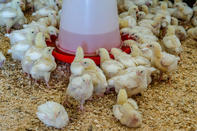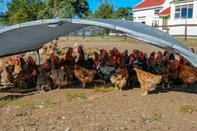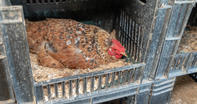The combination of good hygiene, sanitation and disinfection, is highly efficient in removing disease-causing agents from poultry production systems.

It involves the routine removal of dust, soil and organic material, including droppings, blood and secretions, that might contain harmful organisms. Producers should think about “ease of cleaning” when planning and designing a production facility or choosing material to use in the facility.
Clean Food and Water
Poultry birds should have access to clean food and water. Open bowls should be cleaned at least once a day, as birds may step in them, knock them over and get the contents filthy. Spilt water may also wet poultry litter (the combination of poultry bedding and poultry manure) which could lead to diseases and other problems.
Nipple drinking systems are generally easier to clean and also result in less wastage than open bowls. Some of the modern feeders and drinkers are also self-cleaning. Producer, nevertheless, still have to monitor these systems and intervene if problems occur.
Wastewater should be disposed of in a way that does not present any disease risk.
Floor Management

Even free-range birds need access to shelters that would have to be cleaned to prevent a build-up of pathogens. Producers with limited space should consider throwing a cement floor in shelters as cement is easier to clean than soil.
Alternatively, if producers have access to pastures or vegetable gardens, the birds could be kept in mobile coops, also known as chicken tractors.
With this production system, the birds are kept in the coop on the same spot for a couple of weeks, depending on the stocking density, before being moved on to the next spot. The chicken tractor will generally take a long time before moving to the same spot, which helps to prevent a build-up of pathogens.
Bedding

Various forms of bedding may be used to insulate birds from the cold floor, reduce contact with faecal matter, to protect their feet and keep them dry. Whatever bedding material is chosen, it should be quick drying, as wet litter will lead to breast blisters, foot burns and damaged carcasses. The bedding should also be properly managed to prevent a build-up of ammonia and disease-causing organisms.
In commercial production systems, climatic conditions (temperatures and humidity) and ventilation are manipulated to keep the litter dry and to prevent a build-up of ammonia levels, which may encourage the growth of harmful bacteria and fungi.
The litter is turned every day, almost like a plough to loosen caked material. Depending on the type of bedding and whether layers or broilers are produced, clean bedding might be placed in the poultry house before new birds are introduced and removed and disposed of after the birds have been removed.
Poultry House
Poultry houses should be thoroughly cleaned and disinfected after a flock has left and before a new batch is introduced.
The World Organisation of Animal Health advises producers in disinfecting poultry production premises, to destroy disease-carrying vectors, such as flies, mites, ticks, lice, fleas, bugs, beetles and cockroaches, as soon as possible after the birds have been removed from the premises, as insects tend to hide and hibernate as the building cools, making more difficult to eradicate them.
Various chemical compounds are available for vector control. For safe usage and best results, producers should use these products according to instructions.
Rodent control should also be done as soon as possible, according to the OIE, with feed being removed from all feeders to ensure the rodents will be attracted to the baits. Old and stale feed should also be removed, because it may be carrying fungal spores that may cause diseases.
Poultry litter contains large numbers of microbes, so care should be taken to avoid the spreading of dust and feathers during its removal. Litter should be disposed of in a manner that will prevent the spreading of diseases and be kept away from other poultry houses.
Producers should apply health and safety regulations when cleaning the houses, for example, protective clothing, long gloves, rubber boots, wide brim hats and masks should be worn as protection against dust, fungal spores and toxic chemicals. To ease cleaning all movable equipment should be removed and taken to an area for thorough cleaning. Power supplies should also be switched off.
There are three steps during the cleaning process, namely, dry cleaning, wet cleaning and disinfection. During dry cleaning, a broom, brush, shovel, rag or compressed air may be used to remove dust, soil and other organic material from everywhere in the house, including fans, floors, ceilings and steps.
REMEMBER THOUGH, THAT DRY CLEANING SHOULD NOT BE DONE IN HOUSES INFECTED WITH AIRBORNE DISEASES, SUCH AS AVIAN INFLUENZA OR NEWCASTLE DISEASE.
Operations, according to the OIE, should start with the uppermost surfaces and proceed downwards to minimise contamination of previously cleaned areas. Repair work should also be done during this process, with deteriorated material or those that cannot be properly cleaned being removed and replaced by new equipment.
During this phase, all the premises around the poultry houses should also be cleared of debris, dirt and feathers, with a two-meter zone around the house being cleared of vegetation and waste.
During wet cleaning, detergents and soap are used to wash, rinse and soak the area and remove any remaining organic material. According to the Food and Agriculture Organisation of the United Nations presentation on Cleaning & Disinfection of Poultry Farm by Yoni Segal, common detergent powder for washing clothes is a cheap and effective option.
High-pressure washers are also used during this phase, preferably with warm water, to clean surface areas and hard to reach places, as well as air inlets and fan drums.
During disinfection, a disinfectant is used to kill microbes. The South African Poultry Association advises farmers to carefully follow the application instructions, as it will the disinfectant will not be as effective as it should be when too little is used when it is left on for too short a period or it becomes dry before the disinfection period is over.
The quality of water and room temperatures should also be considered during the application process. After disinfection, all equipment is moved back before the house is fumigated in a final attempt to reduce harmful organisms.
By Glenneis Kriel